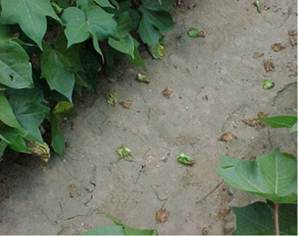Fruit Loss
Last week’s rain was a blessing for our cotton crop but it also set the crop up for fruit loss. In trials to investigate the effects of planting date cotton that was not near cutout exhibited less fruit loss than cotton that was at cutout or beyond.
Cotton planted on April 15th shed most large and mid-sized squares. May 1st planted cotton shed about half as many squares. Cotton planted May 15th or later shed nearly no squares follwing the rain and cloudy conditions. What is important to remember is that as fruit are shed the plant returns to vegetative growth and will need to be monitored closely for the need for plant growth regulator applications.
After a 4 hour drive around west Tennessee this morning (7/17) it was apparent that many fields are already showing a ‘green switch’ in the top of cotton plants indicating that vegetative growth has restarted. Most of the crop is at the stage where 16 oz per acre of mepiquat chloride will be needed to keep growth under control. Tip #1: It is easier to control vegetative growth in smaller plants. If we wait 10 – 14 days to control growth multiple applications will be needed to control rank growth. Get started now to keep the crop maturing as early as possible. Rank growth on the top of the plant will extend the period to keep the crop insect free and could delay harvest into November.
Potassium Deficiency
Potassium deficiency is related to the lake of available potassium for plant uptake. When temperatures rise, growth rates increase and water becomes limiting, potassium is not readily available for root uptake. potassium deficiency usually occurs in older leaves first as it is readily mobile in the plant. Leaves begin to turn light yellowish green with yellow specks appearing between leaf veins and the leaf margin (see picture below). Conditions experienced over the past few weeks (hot, excessive dry conditions with excellent square set and a developing fruit load) caused our cotton to begin displaying potassium deficency. In general rainfall or irrigation relieves the deficiency when the boll load is light and soil tests indicate the potassium is at sufficient levels in the soil. Sandy areas of fields and areas where fragipans are near the surface are most susceptible to displaying potassium deficiency during dry periods. Additionally, potassium uptake is limited as soil pH drops below 6.0. Areas with severe potassium deficency at tis time should be soil tested for potassium levels and pH.
Another symptom of potassium deficiency is the appearance of leaf spot diseases. Peak potassium uptake in cotton takes place during the 3rd to 4th week of bloom. Typically potassium deficiency symptoms can be more severe in early maturing, fast fruiting varieties. The application of foliar fungicides in cotton for leaf spot disease control in Tennessee is generally not recommended. The application of potassium containing foliar fertilizers can help alleviate the visible symptoms of potassium deficiency. However if the cause is lack of rainfall the addition of foliar fertilizers is not recommended.




